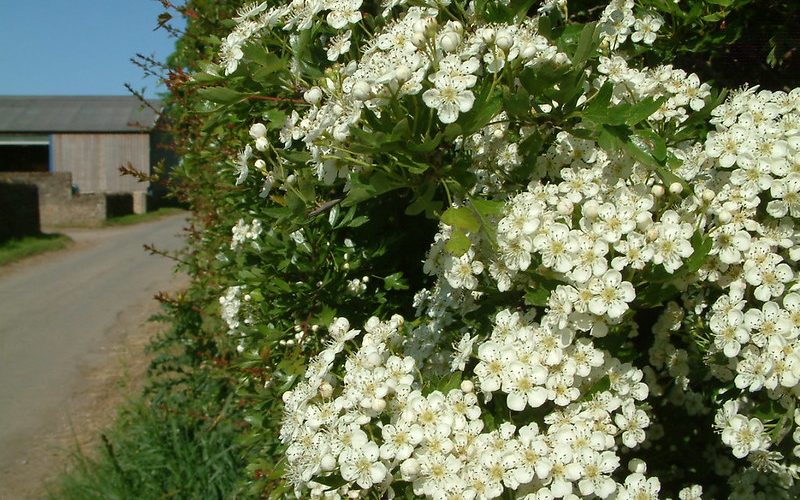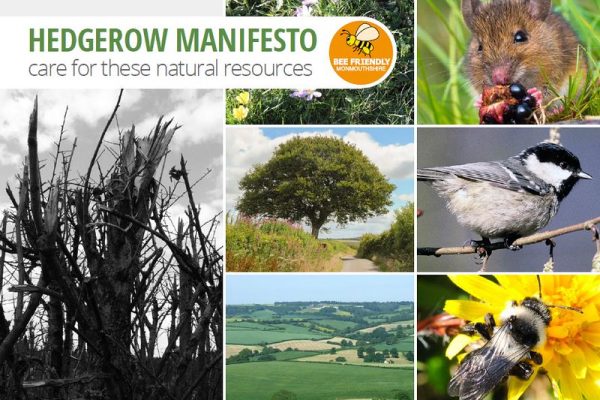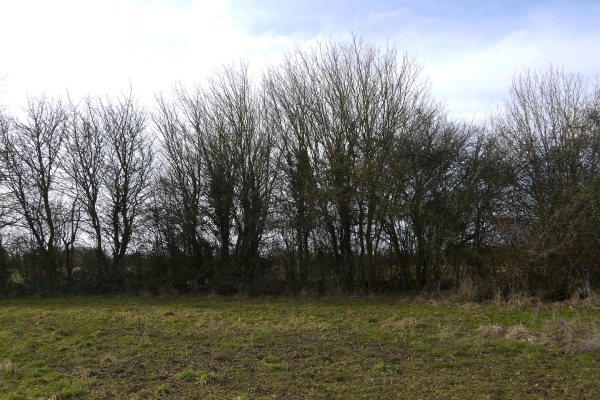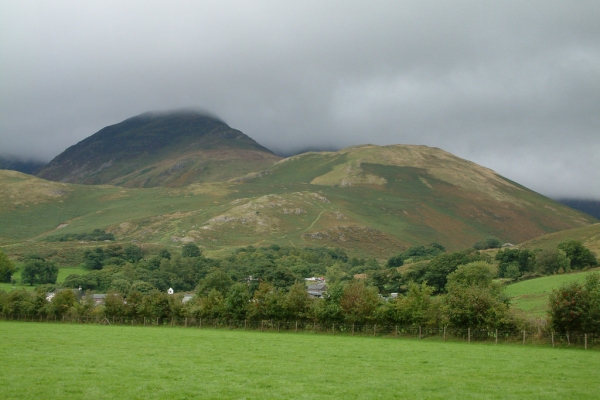May’s green corridors
The bird in the bush is not long out of its nest, discovering how feet and wings work, and still fed by its parents. Cars flash past a few feet away, and for us drivers, this mid-May can be the very best time of year – roadside verges are white with cow parsley, greater stitchwort, wild garlic, and the aptly named Jack-by-the-hedge (garlic mustard) – itself the food plant of orange-tip butterflies.
Hedgerows should be luxuriant green and white too, as the flower which belongs most of all to this month, the May tree or hawthorn, comes into flower. Hawthorn is the most common tree of hedges, and should now be covered in ‘May’ blossom. These white flowers are tremendous engines for biodiversity: they provide nectar and pollen for insects whose pollinatory efforts maintain our ecology.
The insects themselves, over three hundred species living in hawthorn, are in turn food for birds, and also for the bats which patrol these corridors at dusk. Once pollinated, the ‘haw’ fruits feed small mammals and birds, especially migrating thrushes, through autumn until Christmas. As well as providing nectar and pollen for bees and other pollinating insects, the May flowers are eaten by dormice, and were long ago considered food by people too – they have a nutty flavour, so do they explain the folksong ‘Here we go gathering nuts in May’?
Hedgerows and biodiversity
Much of Britain’s wildlife has evolved to live in bushes or woodland, where birds, mammals and insects can find food and rear their young, with chance to hide and escape from predators. As natural habitat disappears, hedgerows have gained new importance in providing this essential bush and tree type of habitat. In fact, hedgerows are now home to around 80% of British woodland birds, 50% of mammals and 30% of butterflies. Britain’s hedges, verges and ditches have become a crucial resource: corridors for wildlife, linking remnants of natural habitat. Thus hedgerows are no longer simply barriers, albeit ancient ones, but are essential habitat for wildlife, including vital insect pollinators.
Viewed in this light, it is time to ensure that hedgerows are maintained in the best ways for the species that must now depend upon them. Modern machinery enables hedgerows to be cut ruthlessly – a spirit level finish that undoubtedly looks ‘tidy.’ However, this is not as nature needs it – some bird species nest four metres above ground.
Bees for Development
I founded the organisation Bees for Development in 1993 to support bees and beekeepers in developing countries. However, it has become apparent that the situation for bees is often poorer here than in some of the financially-poor countries where we work. In 2013 we helped to establish Bee Friendly Monmouthshire, and successfully campaigned for Monmouthshire County Council to adopt a Pollinator Policy in 2014. Later this month, to encourage awareness of the increasing need to cherish hedges, we are publishing a Hedgerow Manifesto.

A leafless hedge in May – offers little value for wildlife with no cover for nesting birds. This hedge has been cut back too often, and too hard; it cannot blossom this year, and unless given chance to recover its leaves and twigs, will gradually die off.
The importance of hedge height and shape
A tall, wide, dense hedge is of greatest value for wildlife. The higher, wider and denser the hedge, the better, with a minimum height of two metres. A thick hedge provides the integrity needed by the farmer, as well as nest sites for birds and small mammals, ideally fenced on the field side if there are grazing stock. An ‘A’ shaped hedge is of most benefit, providing good shelter, stock-proofing and wildlife value. This allows a wide base to be developed and if the top is not trimmed, then hedgerow trees can develop. Some birds like partridges are ground-nesting and need good cover at the base of a hedge.
Our recommendation for best practice is hedge cutting on a three-year rotation. This allows hedgerow shrubs to flower and to produce maximum fruit and seeds, yet enables the hedge’s good shape and density to be maintained.
It is important that all hedges in an area are not trimmed in the same year; best practice is to trim adjacent lengths of hedge in different years, and never to trim hedges on both sides of a road in the same year. Trimming of hedgerows is best done in January or February, when all seeds and berries have been eaten and before nesting begins. Exceptions may be the road-facing sides of hedges that need to be trimmed for safety reasons, and if the hedge contains fast growing species like ash, sycamore or willow, it may need more frequent cutting – in this case, the sides of the hedge may be trimmed every year – but with the top trimmed only every third year, and with any trimming only in January or February. Birds’ main nesting time is between 1 March and 31 August: it is difficult to know when birds are nesting in a hedge, and in some years many are nesting well into August.
Mechanised cutting can achieve satisfactory results if done correctly i.e. cutting twigs rather than major stems. The flail trimmer is designed to cut through material up to a maximum of 2cm thick. When it is used on thicker stems the result is damaged, split stems that are susceptible to fungal diseases, particularly if repeated annually. A healthy hedge can normally recover well from severe cutting; however, repeated, over-zealous cutting will gradually cause a hedge to die off.
Hedge laying remains an important craft because there is no machine which can replicate the work of the hedge-layer. Cattle and horses lean against hedges and make gaps, while sheep push through hedge bases. In hedge laying, the cut stems are bent over at an angle, and these prevent sheep pushing through, while the stakes driven into the hedge and the binding along the top, make the fence strong to resist the weight of cattle or horses. Dead wood is used inside the hedge to protect the regrowth from being browsed by stock, and this provides excellent habitat for insects, especially over winter.
Laying a hedge tidies it and encourages the shrubs to regenerate, keeping the hedge bushy and healthy. Regular trimming will keep the hedge in good order for up to fifty years, when it may be appropriate to lay the hedge again, or even to coppice it. Coppicing i.e. cutting it off completely just above ground level, is a valid way of restoring hedges where the temporary loss of the hedge is acceptable. In conjunction with the planting up of gaps, it can be the best treatment for very overgrown hedges.
Boundary trees are large trees within hedges, and these support considerable biodiversity. There should be no cultivation or weed control within three metres of the base of the tree, and cutting limited to work essential to the safety of people or livestock. Where feasible, fallen branches should be left inside the hedge to help conserve the dead wood needed by insects and fungi.
So next time you are sitting at rural traffic lights, take a look at the hedgerow. If it is well covered in leaves, you may be confident that there is indeed a bird in the bush, and many other species too, all quietly eyeing you.
Editor’s note:
You can explore various Bees for Development resources on Agricology:
- The importance of bees and other insect pollinators
- Land management to support bees and other insect pollinators
- Plants that are valuable for bees and other insect pollinators
- Beekeeping and sustainability













